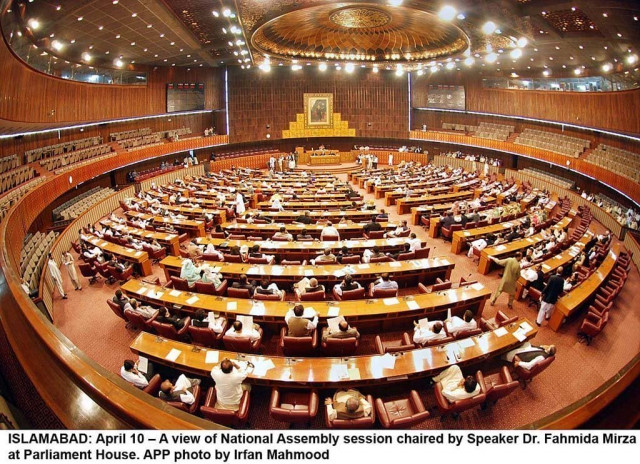NA ‘ignores’ women-sponsored agenda
FAFEN report says women MPs sponsored more parliamentary agenda than men

National Assembly of Pakistan. PHOTO: APP
Similarly, the chair only allowed women 16 per cent of the total parliamentary time allocated to debates, according to a report released by the Trust for Democratic Education and Accountability-Free and Fair Election Network (TDEA-FAFEN).
The percentage of women’s unaddressed agenda in the National Assembly, recorded at 38 per cent, was higher than the percentage of their unaddressed agenda in the Senate, recorded 10 per cent.
However, the Senate was more responsive to women-sponsored agenda.
The NA’s transaction rate — the percentage of the agenda taken up during the proceedings — was 62 per cent in case of women-sponsored agenda, and 67 per cent in case of men-sponsored agenda. The Senate’s transaction rate was 90 per cent related to women-sponsored agenda and 89 per cent in case of men-sponsored agenda.
Most of the agenda sponsored by women, however, was in their private capacities, whereas, government agenda in parliament continues to be men-dominated because of low representation of women in the executive.
Men members of the cabinet accounted for 89 per cent of government business, while women ministers initiated only 11 per cent of government-agenda items. Women’s contribution to government business in the NA was slightly higher (12 per cent) than their contribution in the Senate (eight per cent), presumably due to higher number of women MNAs among parliamentary secretaries.
Among 36 parliamentary secretaries, there are 13 women.
Between March 2019 and February 2020, almost all women members participated in the parliamentary proceedings. Out of the 89 women lawmakers — 69 MNAs and 20 Senators — 87 sponsored agenda and/or participated in the house debates.
Parliamentary agenda by women MPs
Despite being only one-fifth of the current parliament, women MPs sponsored almost double the number of parliamentary agenda as compared to their men counterparts.
They also collaborated with them in sponsoring matters of public interest in parliament. Women along with men parliamentarians jointly sponsored half (51 per cent) of the calling attention notices in the NA.
Around 13 per cent amendments to the rules of procedure, nine per cent private members’ bills, and seven per cent resolutions were jointly coined by men and women in the lower house. In the Senate, 20 per cent motions for public importance debates, eight per cent resolutions and two per cent private members’ legislation was jointly sponsored by men and women.
Moreover, women’s contribution to the NA’s agenda was relatively greater than their contribution to the Senate’s agenda. Women MNAs sponsored 36 per cent of the NA agenda — 33 per cent on their own and three per cent in collaboration with their men colleagues. In the Senate, women brought a quarter of the parliamentary business — 22 per cent on their own and three per cent in collaboration with men.
They also outperformed their Senate counterparts in regularity. Women MNAs attended 80 per cent of the sittings, while women Senators 75 per cent.
However, women Senators remained more active during the house debates in comparison to women MNAs. Each woman MNA took part in the debates for an average of 11 minutes, whereas each woman Senator averaged 26 minutes.
On average, each woman legislator sponsored at least 16 agenda items and spoke at least three times on the floors of the houses.
Apart from contributing to the overall parliamentary agenda, women parliamentarians also regularly attended sessions. On average, each woman parliamentarian attended 79 per cent of the parliamentary sittings, while this ratio stood at 66 per cent for men.
Women MNAs’ agenda contribution declines
Women’s contribution to the parliamentary business has varied over time. The contribution of women MNAs has dwindled from two-third to around one-third since 2009 when the TDEA-FAFEN first launched its annual performance analysis. On the contrary, since 2015, women Senators’ contributions have surged from 18 to 25 per cent.



















COMMENTS
Comments are moderated and generally will be posted if they are on-topic and not abusive.
For more information, please see our Comments FAQ